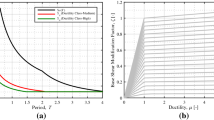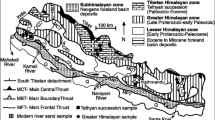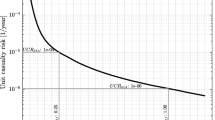Abstract
Seismic risk evaluation (SRE) in early stages (e.g., project planning and preliminary design) for a mountain tunnel located in seismic areas has the same importance as that in final stages (e.g., performance-based design, structural analysis, and optimization). SRE for planning mountain tunnels bridges the gap between the planning on the macro level and the design/analysis on the micro level regarding the risk management of infrastructural systems. A transition from subjective or qualitative description to objective or quantitative quantification of seismic risk is aimed to improve the seismic behavior of the mountain tunnel and thus reduce the associated seismic risk. A new method of systematic SRE for the planning mountain tunnel was presented herein. The method employs extension theory (ET) and an ET-based improved analytical hierarchy process. Additionally, a new risk-classification criterion is proposed to classify and quantify the seismic risk for a planning mountain tunnel. This SRE method is applied to a mountain tunnel in southwest China, using the extension model based on matter element theory and dependent function operation. The reasonability and flexibility of the SRE method for application to the mountain tunnel are illustrated. According to different seismic risk levels and classification criteria, methods and measures for improving the seismic design are proposed, which can reduce the seismic risk and provide a frame of reference for elaborate seismic design.
Similar content being viewed by others
References
Aminbakhsh S, Gunduz M, Sonmez R (2013) Safety risk assessment using analytic hierarchy process (AHP) during planning and budgeting of construction projects. Journal of Safety Research 46: 99–105. https://doi.org/10.1016/j.jsr.2013.05.003
Asakura T, Tsukada K, Matsunaga T, et al. (2000) Damage to mountain tunnels by earthquake and its mechanism. Doboku Gakkai Ronbunshu 659: 27–38. https://doi.org/10.2208/jscej.2000.659_27
Bieniawski ZT (1989) Engineering Rock Mass Classifications: A Complete Manual for Engineers and Geologists in Mining, Civil, and Petroleum Engineering. A Wiley-Interscience Publication, New York, US.
Bobet A, Einstein HH (2011) Tunnel reinforcement with rockbolts. Tunnelling and Underground Space Technology 26: 100–123. https://doi.org/10.1016/j.tust.2010.06.006
Cai W (1990) Extension Set and Non-Compatible Problems Advances in Applied Mathematics and Mechanics in China, pp. 1–21.
Cai W (1999) Extension theory and its application. Chinese Science Bulletin 44(17): 1538–1548. https://doi.org/10.1007/BF02886090
Cai W (2013) Extension Engineering Methods. Science Press, Beijing, China.
Cerić A, Marčić D, Ivandić K (2011) A risk-assessment methodology in tunnelling. Technical Gazette 4(18): 529–536.
Chen LJ, Liang B (2011) Analysis of Anti-seismic Fortified Length of Tunnel Portal in High Seismic Intensity Area. Applied Mechanics and Materials 90–93: 2057–2061. https://doi.org/10.4028/www.scientific.net/AMM.90-93.2057
Chen ZY, Shi C, Lin TB, Yuan Y (2012) Damage characteristics and influence factor of mountain tunnels under strong earthquakes. Natural Hazards 61(2): 387–401. https://doi.org/10.1007/s11069-011-9924-3
Codermatz R, Nicolich R, Slejko D (2003) Seismic risk assessments and GIS technology: applications to infrastructures in the Friuli-Venezia Giulia region (NE Italy). Earthquake Engineering and Structural Dynamics 32: 1677–1690. https://doi.org/10.1002/eqe.294
Cui GY, Wu XG, Wang MN, et al. (2017) Earthquake damages and characteristics of highway tunnels in the 8.0-magnitude Wenchuan earthquake. Modern Tunnelling Technology 54(2): 9–15. (In Chinese) https://doi.org/10.13807/j.cnki.mtt.2017.02.002
Dowding CH, Rozen A (1977) Damage to rock tunnels from earthquake shaking. Journal of Geotechnical Engineering Division: 104(2): 175–191.
Du YP, Zhang Y, Zhao XG, et al. (2014) Risk evaluation of bogie system based on extension theory and entropy weight method. Computational Intelligence and Neuroscience. 2014: 1–6. https://doi.org/10.1155/2014/195752
Earthquake Engineering Research Institute (2002) Sichuan Earthquake Administration. Engineering site seismic safety evaluation report (In Chinese)
Fang XQ, Lin JQ, Zhou XL, et al. (2008) Damage evaluation of tunnels in earthquakes, The 14th World Conference on Earthquake Engineering, Beijing, China, pp. 1–9.
Fan ZF, Zhang JC, Xu H (2019) Theoretical study of the dynamic response of a circular lined tunnel with an imperfect interface subjected to incident SV-waves. Computers and Geotechnics 110: 308–318. https://doi.org/10.1016/j.compgeo.2019.02.026
Fan ZF, Zhang JC, Xu H, et al. (2019) Transmission of normal p-wave across a single joint based on g-λ model. Shock and Vibration. vol. 2019, pp. 1–10. https://doi.org/10.1155/2019/8240586
Genis M (2010) Assessment of the dynamic stability of the portals of the Dorukhan tunnel using numerical analysis. International Journal of Rock Mechanics & Mining Sciences 47(8): 1231–1241. https://doi.org/10.1016/j.ijrmms.2010.09.013
Gao F, Shu XG, Xue DL et al. (2014) Study on effect of seismic joint to seismic response of tunnel passing through fault. 482: 252–255. https://doi.org/10.4028/www.scientific.net/AMM.482.252
GB 50111-2006 Code for seismic design of railway engineering. China Planning Press, Beijing. (In Chinese)
Huang F, Zhao LH, Ling TH, et al. (2017) Rock mass collapse mechanism of concealed karst cave beneath deep tunnel. International Journal of Rock Mechanics & Mining Sciences (91): 133–138. https://doi.org/10.1016/j.ijrmms.2016.11.017
Hyun KC, Min S, Choi H, et al. (2015) Risk analysis using fault-tree analysis (FTA) and analytic hierarchy process (AHP) applicable to shield TBM tunnels. Tunneling and Underground Space Technology. 49: 121–129. https://doi.org/10.1016/j.tust.2015.04.007
JTG B02-2013 Specifications of Earthquake Resistant Design for Highway Engineering. China Communications Press, Beijing. (In Chinese)
Kaya A, Karaman K, Bulut F (2017) Geotechnical investigations and remediation design for failure of tunnel portal section: a case study in northern Turkey. Journal of Mountain Science 14(6): 1140–1160. https://doi.org/10.1007/s11629-016-4267-x
Lu CC, Hwang JH (2018) Damage analysis of the new Sanyi railway tunnel in the 1999 Chi-Chi earthquake: Necessity of second lining reinforcement. Tunneling and Underground Space Technology. 73: 48–59. https://doi.org/10.1016/j.tust.2017.12.009
Li KG, Hou KP, Li W (2009) Research on influences of factors dynamic weight on slope stability. Rock and Soil Mechanics 30(2): 492–496. (In Chinese)
Li TB (2012) Damage to mountain tunnels related to the Wenchuan earthquake and some suggestions for aseismic tunnel construction. Bulletin of Engineering Geology and the Environment 71(2): 297–308. https://doi.org/10.1007/s10064-011-0367-6
Okamoto S. (1984) Introduction to Earthquake Engineering (2nd Ed). University of Tokyo Press, Tokyo, Japan.
Oh J, Moon T (2018) Seismic design of a single bored tunnel: longitudinal deformations and seismic joints. Rock Mechanics and Rock Engineering 51: 893–910. https://doi.org/10.1007/s00603-017-1366-0
Qin CB, Chian SC (2017) 2D and 3D stability analysis of tunnel roof collapse in stratified rock: Akinematic approach. International Journal of Rock Mechanics and Mining Sciences. 100: 269–277. https://doi.org/10.1016/j.ijrmms.2017.10.027
Roy N, Sarkar R (2017) A review of seismic damage of mountain tunnels and probable failure mechanisms. Geotechnical and Geological Engineering 35: 1–28. https://doi.org/10.1007/s10706-016-0091-x
Şandru OI, Vladareanu L, Şchiopu P, et al. (2013) Multidimensional Extenics Theory. Upb Scientific Bulletin, Series A 75: 4–12.
Saaty TL (1980) The Analytic Hierarchy Process. McGraw-Hill International, New York, US.
Sharma S, Judd WR (1991) Underground opening damage from earthquakes. Engineering Geology 30(3–4): 253–275. https://doi.org/10.1016/0013-7952(91)90063-Q
Shen YS, Gao B, Yang XM, et al. (2014) Seismic damage mechanism and dynamic deformation characteristic analysis of mountain tunnel after Wenchuan earthquake. Engineering Geology 180: 85–98. https://doi.org/10.1016/j.enggeo.2014.07.017
Soren DK, Per T, Jorgen K, et al. (2004) Guidelines for tunneling risk management: International Tunnelling Association Working Group No.2. Tunnelling and Underground Space Technology 19(3): 217–237. https://doi.org/10.1016/j.tust.2004.01.001
Sui CY, Gao B, Shen YS et al. (2017) Shaking table tests and analysis on tunnel structures with high steep slope. Journal of vibration and shock 36(19): 186–194. (In Chinese) https://doi.org/10.13465/j.cnki.jvs.2017.19.029
Wang J, Erdik M, Otake S (2005) Seismic hazard assessment and earthquake resistant design considerations for the Bosphorus tunnel project Underground Space Use: Analysis of the Past and Lessons for the Future — Erdem & Solak (eds), pp. 1295–1303.
Wang MN, Cui GY, Lin GJ (2009) Investigation and preliminary Analysis on Seismic Tunnel Damages in Wenchuan earthquake District. Xi Nan Gong Lu 4: 41–46. (In Chinese).
Wang SS, Gao B, Sui CY, et al. (2014) Shaking table test for seismic behavior of upward slope at tunnel entrance in different geological conditions. Rock and Soil Mechanics 35: 278–284. (In Chinese)
Wang SS, Gao B, Fan KX, et al. (2018) Damping mechanism of shallow cylindrical parallel tunnel with grouting reinforcement zone. Rock and Soil Mechanics 39(2): 683–690. (In Chinese) https://doi.org/10.16285/j.rsm.2016.0505
Wang WL, Wang TT, Su JJ, et al. (2001) Assessment of damage in mountain tunnels due to the Taiwan Chi-Chi Earthquake. Tunnelling and Underground Space Technology 16: 133–150. https://doi.org/10.1016/S0886-7798(01)00047-5
Wang ZZ, Zhang Z (2013) Seismic damage classification and risk assessment of mountain tunnels with a validation for the 2008 Wenchuan earthquake. Soil Dynamics and Earthquake Engineering 45: 45–55. https://doi.org/10.1016/j.soildyn.2012.11.002
Wang ZZ, Jiang YJ, Zhu CA (2017) Seismic energy response and damage evolution of tunnel lining structures. European Journal of Environmental and Civil Engineering 23(6): 758–770. https://doi.org/10.1080/19648189.2017.1304283
Wu PC, Wang MH, Lin TC (2014) Risk Assessment of Building Fire Safety Based on the Extension Theory. Computer, Consumer and Control (IS3C), 2014 International Symposium. pp 872–875.
Xiong ZM, Guo JT, Xia YP, et al. (2018) A 3D Multi-scale geology modeling method for tunnel engineering risk assessment. Tunneling and Underground Space Technology. 73: 71–81. https://doi.org/10.1016/j.tust.2017.12.003
Xu H (2009) Research on Seismic Dynamic Response and Aseismic Stability of Mountain Tunnel in High-intensity zone. Ph. D Dissertation, Chengdu University of Technology, Chengdu, China.
Xu H, Li TB (2011) Seismic dynamic response and damping effect analysis of different buffer layers on tunnels. China Civil Engineering Journal 44(Supp): 201–208. (In Chinese) https://doi.org/10.15951/j.tmgcxb.2011.s1.028
Xu H, Li TB, Wang D, et al. (2013) Study of seismic responses of mountain tunnels with 3D shaking table model test. Chinese Journal of Rock Mechanics and Engineering 32(9): 1762–1771. (In Chinese) https://doi.org/10.3969/j.issn.1000-6915.2013.09.005
Xu H, Li TB, Xu JS, et al. (2014) Dynamic response of underground circular lining tunnels subjected to incident P waves. Mathematical Problems in Engineering Article ID: 297424. https://doi.org/10.1155/2014/297424
Xu H, Li TB, Xia L, et al. (2016) Shaking table tests on seismic measures of a model mountain tunnel. Tunneling and Underground Space Technology. 60: 197–209. https://doi.org/10.1016/j.tust.2016.09.004
Xie HT (2013) Numerical analysis on influence of transverse section shape on earthquake resistant capability of shallow-buried tunnel. Applied Mechanics and Materials 405: 1292–1296.
Xiong LX (2006) Numerical simulation studies on earthquake resistant of mountain tunnels at active fault zone, Chengdu University of Technology, Chengdu, China. (In Chinese)
Yashiro K, Kojima Y (2007) Historical earthquake damage to tunnel in Japan and case studies of railway tunnels in the 2004 Niigataken-Chuetsu earthquake. QR of RTRI, 48(3): 136–141.
Yu HT, Chen JT, Bobet A, et al. (2016) Damage observation and assessment of the Longxi tunnel during the Wenchuan earthquake. Tunnelling and Underground Space Technology 54: 102–116. https://doi.org/10.1016/j.tust.2016.02.008
Zhao X, Li TB, Tao L, et al. (2013) Failure Mechanism of Tunnel Portal during Strong earthquakes. International Efforts in Lifeline Earthquake Engineering, pp. 314–320.
Zhou Y, Qian X, Zhao JH, et al. (2009) Application of extension theory to the evaluation of coal mines geological safety. Control and Decision Conference, pp.4937–4941.
Zulauf C (2012). Risk evaluation for road tunnels: current developments. 6th International Conference ‘Tunnel Safety and Ventilation’, Graz, pp. 26–33.
Zhang XP, Jiang YJ, Sugimoto (2018) Seismic damage assessment of mountain tunnel: A case study on the Tawarayama tunnel due to the 2016 Kumamoto Earthquake. Tunnelling and Underground Space Technology. (71): 138–148. https://doi.org/10.1016/j.tust.2017.07.019
Zhao XJ, Xu H (2012) Magnitude-Scaling Rate in Ground-Motion Prediction Equations for Response Spectra from Large Subduction Interface Earthquakes in Japan. Bulletin of the Seismological Society of America 102(1): 222–235. https://doi.org/10.1785/0120110154
Zhao XJ, Xu H (2013) A Comparison of VS30 and Site Period as Site-Effect Parameters in Response Spectral Ground-Motion Prediction Equations. Bulletin of the Seismological Society of America 102(1): 1–18. https://doi.org/10.1785/0120110251
Zang WJ (2017) Damage to highway tunnels caused by the Wenchuan earthquake. Modern Tunnelling Technology 54(2): 17–25. (In Chinese) https://doi.org/10.13807/j.cnki.mtt.2017.02.003
Zhu CA, Sun RF, Xu H, et al. (2019) Evaluation of Ground Surface Pre-grouting in a Mountain Tunnel Based on FAHP. Mathematical Problems in Engineering. https://doi.org/10.1155/2019/2543584
Acknowledgments
This study was financially supported by the National Key Research and Development Program of China (2016YFB1200401) and the Western Construction Project of the Ministry of Transport (Grant No. 2015318J29040). This support is gratefully acknowledged.
Author information
Authors and Affiliations
Corresponding author
Rights and permissions
About this article
Cite this article
Xu, Js., Xu, H., Sun, Rf. et al. Seismic risk evaluation for a planning mountain tunnel using improved analytical hierarchy process based on extension theory. J. Mt. Sci. 17, 244–260 (2020). https://doi.org/10.1007/s11629-018-5267-9
Received:
Revised:
Accepted:
Published:
Issue Date:
DOI: https://doi.org/10.1007/s11629-018-5267-9




